“Where are you going next week?” Praveen asked as we sipped Coffee in office. “Is it a long weekend?” I questioned. “Yeah, 24 Aug is a holiday. I am going to Pondy….Haven’t you planned anything?”
This question set in motion for our next “Long Weekend” trip. The planning part of any trip is exciting as well as tiring. We had done most places around. “Where next” I asked my wife. As we started googling, an idea stuck. Why not “Malnad in monsoons”? she asked. We hit upon going to Tirthahalli in Malnad region of Karnataka. Malenadu or Malnad in Kannada means “Hilly region” of Western Ghats consisting of Shivamogga, Chikkamagalur, Coorg and parts of coastal districts.
A stream flowing gently in the forest.
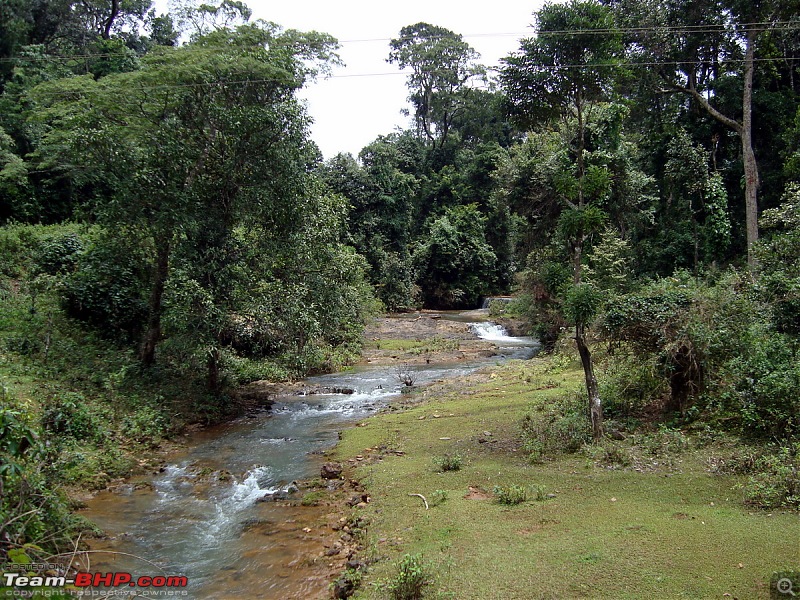
There were some challenges before we could embark on this plan. First was the road condition to Shivamogga and then on to Tirthahalli. We had a harrowing experience driving on this road two years back from Goa. We became adventurous and drove via Karwar, visiting Jog falls on the way.
But the road from Shivamogga to Kadur (a distance of 50 KMs) was sheer misery. My fiesta had a torrid time negotiating craters and it took us two hours to cover this stretch. We wanted to be doubly sure about road. Once confirmed good - thanks to BHPians -heaved a sigh of relief and moved to next challenge. Where do we stay?
Shivamogga district has fabulous flora, fauna, hills, water falls, heritage…….you name it and it has.
But it does not have many good places to stay. Tourism has not picked up in the region and road conditions discouraged visitors. Googling and talking to some friends helped us decide to stay in Tirthahalli to explore Malnad. This led us to BANANKI HOMESTAY (
Homestay in Thirthahalli :: Bananki Home Stay ). Having confirmed acco, we were raring to go.
Bananki Home Stay 
Staying on Bannerghatta road has some advantages – though going to office located in other corner of city is a pain – as NICE road is close by. When we reached the NICE road start point on Kanakapura road – after packing idlis from a darshini enroute – it was 8 AM.
The road till Tumkur was excellent. After Tumkur we branched out on NH 206. The road was surprisingly good with hardly any traffic. The recent rains had turned the parched lands in Tumkur district green. We spotted a cute little church – looked like built by British – in Gubbi town. Lo and behold! We were in Shivamogga at 12.30 Noon having covered a distance of 280 KMs in 4.30 Hours with a break of fifteen minutes for eating idlis! The drive from Shivamogga to Tirthahalli was fabulous as we entered the“Male nadu”.
Driving through green expanse on the winding road with small ponds with lilies on the sides made it a pleasure. We also saw the backwaters of Gajanur dam built on Tunga River and Mandagadde bird sanctuary on this stretch.
A Green Canopy on Shivamogga - Tirthahalli road  Birds @ Mandagadde
Birds @ Mandagadde 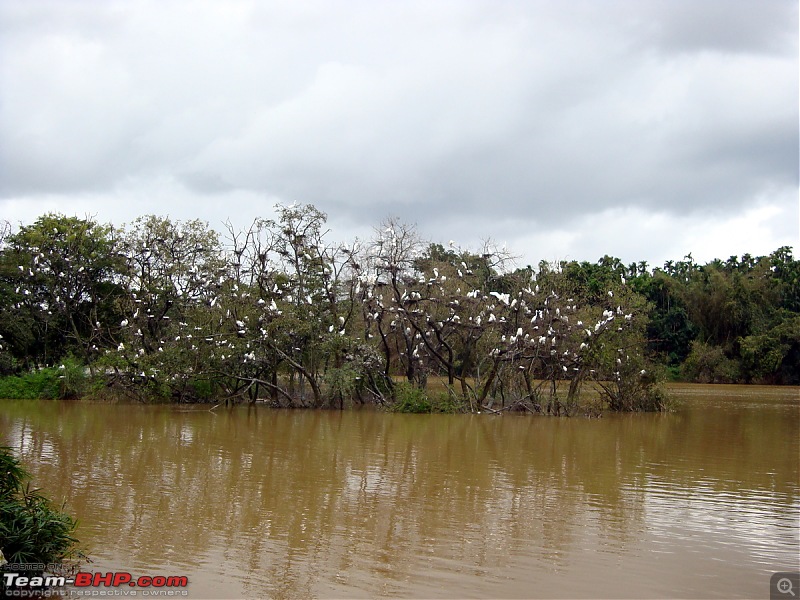
When we reached Bananki, it was 2 PM. Rachan and Arpita – the young couple whose home it is – were there to receive us. This is a sprawling bungalow amidst a plantation with well-kept garden around. The old bungalow has been renovated by the couple. They provide three rooms inside the bungalow and have built two small cottages as well. The lunch – traditional Malnad vegetarian cuisine as we are veg – was god sent. It was just the beginning of our wonderful gastronomical journey in Bananki. Arpita is very good at preparing the food and we had our fill. After resting for a while we were on the road again.
Our first stop was “Kavi Shyla” – the memorial for Kuvempu, the great poet and littérateur in Kannada. (
Kuvempu - Wikipedia, the free encyclopedia ) The memorial has been built by a team of his disciples and family with lot of love and affection. It shows in the way the ancestral home of Kuvempu has been renovated and converted into a nice museum.
KUVEMPU's house 
The museum has display of rare photographs, items used by the poet, awards and medals won. I have never seen a better memorial to any Indian littérateur (I have not seen Tagore memorial in Shanti Niketan.) The “Kavi Shyla” close to the memorial is a hillock where the poet used to go to draw inspiration from. The setting of the hill is just stunning. It has panoramic views of Sahyadri Mountains with lush green paddy fields in the valley. The team has created “Stonehenge” kind of structure around the place where the poet was cremated. The place has been developed with lot of aesthetic sense.
Sringeri – the famed temple town – was the next stop. (
Shringeri - Wikipedia, the free encyclopedia) After visiting temples of Sharada Devi and Vidya Shankara, we spent some time on the serene environs of the river before heading back.
We were skeptical when we booked in “Bananki”. We had stayed only once in a home stay in Coorg and the experience was very good. Thus, we were not sure what was in store. However we were in for a nice surprise. Rachan and Arpita were not only good hosts but were passionate in making their guest comfortable. The best part of our stay in Bananki was the excellent traditional “Malnad cuisine” – Buns – a Mangalore delicacy, oththu shavige with kayi haalu (rice samiya with coconut milk), Neeru dose with kobri chutney, gantu pongal and akki roti, divya halasu (wild jack fruit) fry, were some of the delicacies. To top it all was the great filter coffee. The secret was revealed when Arpita said she comes from a family of planters in Chikkamagalur! They were disappointed that we are veggies lest they could have provided a feast of chicken etc!!
The day dawned with chirping of birds and cries of peacock! After an excellent cuppa, we stepped outside into the garden to see some beautiful birds. Not being a birder, I could only identify a woodpecker. The binoculars came in handy as we were able to see at least six types of birds.
“Why don’t we go far a small walk” asked Brinda. I was game for it and Rachan recommended us to take a path going down the bungalow leading to a small stream below. Not minding a slight drizzle, we stepped out. The light drizzle, young sun and greenery made the walk a pleasure. On the way, we could see a cute little pond with fringed with bent trees.
The small pond close to Bananki 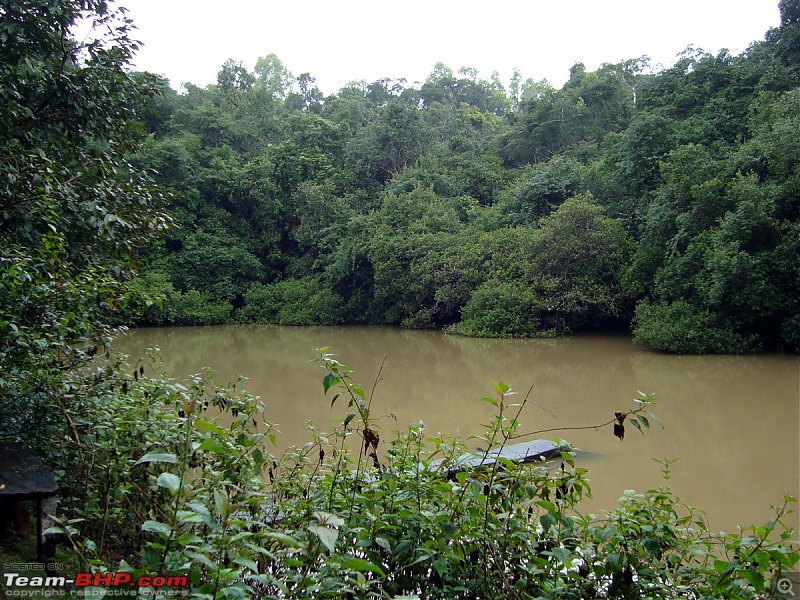
We came back and Brinda (my wife) opened her shoe to see in horror a swollen leach between her toe fingers! Lo behold! She was seeing it for the first time and was naturally scared.

I told her not to worry, went to kitchen and removed it after smearing it with lime (Sunna/chuna). The lime is supposed to help in clotting blood quickly.
Breakfast done, we hit the road. We wanted to go off beaten track and just drive in the forests. Our first stop enroute to Nagara was Ambu Thirtha - birth place of Sharavathi River. On the way we passed by Kavale Durga – a small fort atop a hill – with fabulous views of hills. As we entered the Nagara town, we stood bowled over by the fort. The setting – on a small hillock with a lake in the foreground – is romantic and reminded me of Mandu in Madhya Pradesh which I visited 20 years ago as an young officer in Army.
Nagara fort with lake in foreground 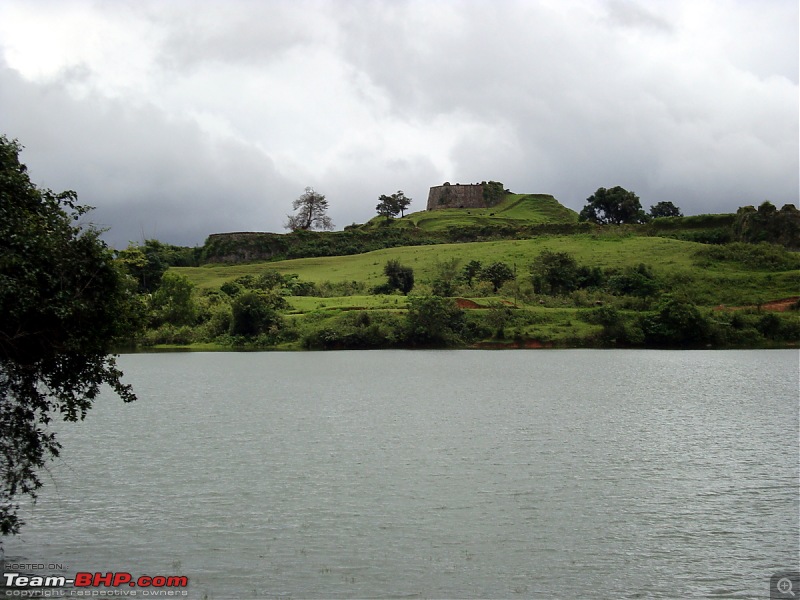 Entrance to Nagara fort
Entrance to Nagara fort 
The fort can be covered in 45 minutes. We were keen to see the backwaters of Linganamakki Dam. An hour’s drive from Nagara through woods and streams landed us at the boarding site for ferry. This place was just breathtaking.
It was huge expanse of water. The clouds, clear water, small islands, submerged tree trunks give this place a tranquil and serene feel. I had thought Thekkady to be picturesque, but this place beats it by miles. The shores are ideal spots for camping. We put our car in ferry and crossed over in ten minutes. Enroute to Sagara, we saw the famous temple at Ikkeri.
The mesmerising beauty of Linganamakki Backwaters 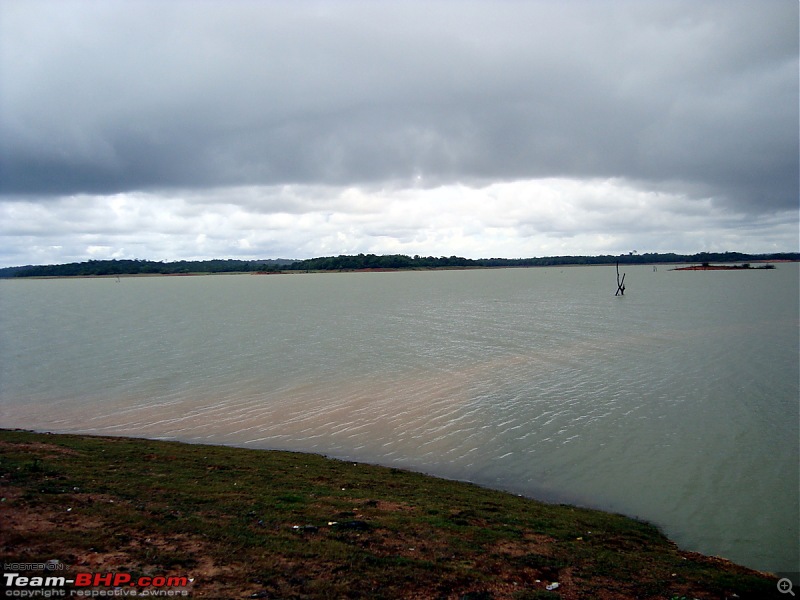
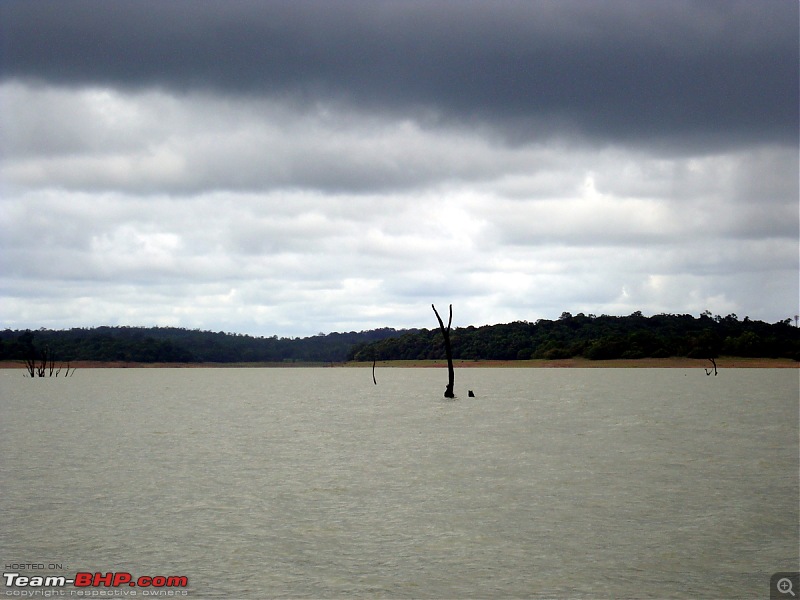

As we reached Sagara, we were in dilemma. To go to Jog Falls or not. We had seen Jog in full glory couple of years back. It was already 4.30 in the evening and the clouds were giving an early warning. Jog is unpredictable in the evening as envelope of mist blocks the view of falls. We decided against and instead moved towards HEGGODU, the cultural centre with NINASAM repertory (
Ninasam - Wikipedia, the free encyclopedia) established by KV Subbanna, Magsaysay Award winner. It is a small village known for many cultural and sustainable livelihood activities. Every October, Heggodu comes alive for a week during “Cultural Festival” where literary, development seminars, cultural shows are held.
The day was well spent. Leisurely drives in the woods are a good kick indeed. The dinner was fabulous as ever, specially the soup.
Packing up next day, we planned to leave after an early breakfast. Rachan suggested visiting Bheemana Katte, a small unspoiled place on the banks of Tunga River. River Tunga creates numerous sandy beaches during its course and Bheemana Katte happens to have one of the longest. There was a plan to mine the sand but local opposition drove away the contractors. Thus the place was saved!
Sandy beach @ Bheemanakatte 

On the way, we wanted to visit Bhadra reservoir in Lakkavalli near Tarikere. But it started raining and we decided against. As we drove back, we promised ourselves to come back to “Malnad” and savour the other sights we had not explored – Kundadri, Kodachadri, Kavale Durga, Gudavi, Belligave, Gherusoppa, Hidlamane Falls, Koodli, Chandragutti, Kanoor fort, Bhadra reservoir, Sakrebylu elephant camp, Tyavare koppa safari……………and many other places.
We felt that here is an excellent alternate destination to Pondy, Coorg, Ooty, Wayanad, Chikkamagalur and Yercaud for your long week ends. One can comfortably spend three days exploring the places. If you are a trekker add couple of more days.
 (1)
Thanks
(1)
Thanks











 I told her not to worry, went to kitchen and removed it after smearing it with lime (Sunna/chuna). The lime is supposed to help in clotting blood quickly.
I told her not to worry, went to kitchen and removed it after smearing it with lime (Sunna/chuna). The lime is supposed to help in clotting blood quickly.







 and i will take care of your suggestions in future.
and i will take care of your suggestions in future.





